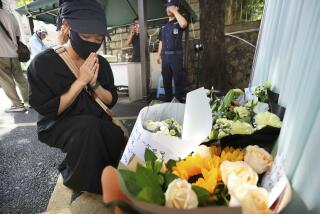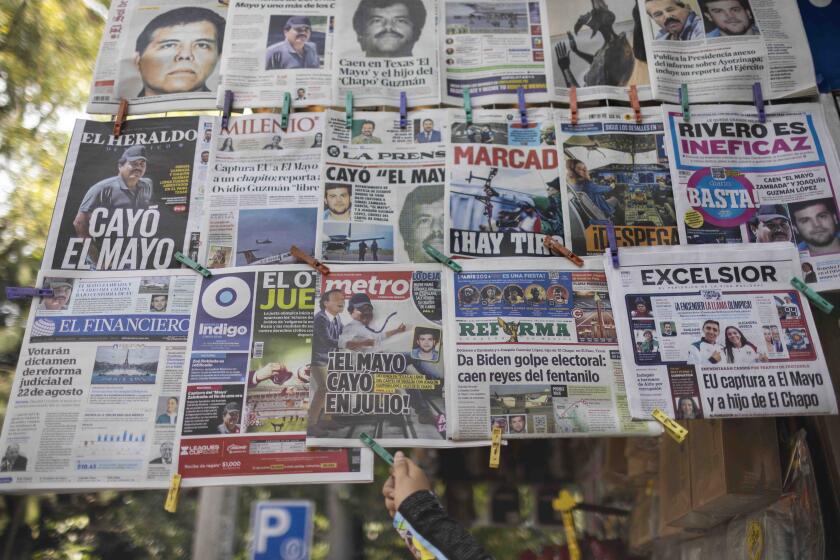Japanese Storm Hijacked Jet; 364 Aboard Safe
Police stormed a hijacked jumbo jet today, freeing 364 hostages held by a man apparently seeking freedom for imprisoned cult leader Shoko Asahara, who is accused of masterminding a poison gas attack in Tokyo’s subways.
The lightning assault--uncharacteristically bold for Japan--ended a nearly 16-hour drama broadcast live on television to a nation still fearful that members of the Aum Supreme Truth sect may launch new terrorist attacks in response to the arrest of their leader.
“Inhumane action cannot be forgiven,” Chief Cabinet Secretary Kozo Igarashi, the government’s top spokesman, said after the operation succeeded. “From now on, we will handle hijackings with a very strong attitude.”
TV crews, advised that the hijacker might be monitoring their broadcasts, cooperated with police by focusing live cameras only on the cockpit area when a special team of 20 riot police slipped up to the All Nippon Airways Boeing 747 parked on the runway at Hakodate airport in northern Japan.
The operation was launched at 3:42 a.m. local time (10:42 a.m. PDT Wednesday) and the lone hijacker was captured within three minutes.
Recorded TV footage was then broadcast showing police scrambling up small ladders through hatches into the plane’s underbelly. From there, they burst into the cabin area and quickly overpowered the hijacker, who turned out to be acting alone, though he had claimed to have accomplices.
While authorities did not immediately announce where the police team that carried out the operation was based, a commentator on Asahi Television said it was a special anti-hijack team from the Tokyo Metropolitan Police Department. The commentator urged that such teams be set up in every prefecture of Japan that has an airport.
The existence of such a team, if the commentator was correct, had not been general knowledge in Japan, although reports of the secret formation of such a team appeared in the Japanese press nearly 20 years ago, after a humiliating 1977 capitulation by Tokyo to terrorists holding a hijacked jetliner at Dhaka airport in Bangladesh.
Until Wednesday’s hijacking, Japan had gone for 16 years without a domestic hijacking, and a special anti-hijack squad had never been used here before.
The hijacker, dressed in jeans and a white golf shirt, was first taken to a police station. He was seen being escorted into the building, his shirt bloodied and a scarf wrapped around his head. He was later taken to a hospital. The suspect identified himself as Fumio Kutsumi, 53, of Tokyo but refused to disclose his motive, police said.
However, according to Yuzuru Matsumoto, managing director of All Nippon Airways, or ANA, the plane’s crew had quoted the hijacker as saying, “I did it for Asahara!” referring to the Supreme Truth leader, whose sect has been accused of the March poison gas attack in Tokyo’s subways that killed 12 and sickened more than 5,500.
Reports in the initial hours of the hijacking on Wednesday indicated that the pilot believed the hijacker was a cult member and that he was demanding Asahara’s release.
Later in the evening, however, in a statement to NHK Television relayed though a flight attendant who called the station on a cellular phone, the hijacker denied having said he was a cult member or having made any demand about Asahara.
Seven passengers and crew members, including a woman who was stabbed by the hijacker with a sharpened screwdriver, were taken by ambulance to nearby hospitals.
Igarashi said the government decision to storm the plane was greatly assisted by passengers who telephoned on cellular phones with news of the situation on the plane.
Some telephoned from their seats, and others dialed out during visits to the toilet, television news reports said.
Throughout the ordeal, the hijacker had refused to allow food to be brought onto the airplane. Hunger, tension and rising humidity left many of the passengers exhausted.
Also, on orders from the hijacker, flight attendants had blindfolded many of the passengers, tying the hands of some and, in some cases, putting masking tape over passengers’ mouths.
Passengers interviewed on television, however, generally had praise for authorities and the flight crew. Passengers generally remained calm throughout the ordeal.
As for authorities here, although they eventually allowed the storming of the jet, their response to the hijacking was still marked by a considerable degree of caution, as they took hours to move against a man who turned out to be acting alone and armed only with a sharpened screwdriver. But the sudden and aggressive ending to the standoff still presented a sharp contrast to the weakness Tokyo showed in the 1970s.
A spectacular cave-in to Japanese Red Army hijackers’ demands bought freedom for all 140 passengers and crew on a Japan Airlines plane held at Dhaka airport in Bangladesh in 1977. But it left an enduring image of a Japan that cannot say “No” to hostage-holding terrorists.
“The lives of people are weightier than the Earth itself,” then-Prime Minister Takeo Fukuda said in explaining Tokyo’s decision to release six prisoners and pay the hijackers a $6-million ransom to free those Dhaka hostages. The hijackers were allowed to fly to freedom in Algeria.
The sentiments expressed by Fukuda remain strong in Japan.
But news reports today said that in direct response to the Dhaka incident, a police manual was drawn up outlining more aggressive ways of dealing with hijackings. Formation of the team that freed the hostages in Hakodate apparently was also a direct result of the Dhaka fiasco.
“Japan was shamed in front of the whole world by the Dhaka case, and the Red Army people released then are still causing trouble,” Defense Agency spokesman Takahiro Ishihara said Wednesday.
The Japan Times reported in late 1977 that a special team had been secretly set up by the Tokyo Metropolitan Police Department. But there has never been official confirmation of the team.
Megumi Shimizu of The Times’ Tokyo Bureau contributed to this report.
More to Read
Sign up for Essential California
The most important California stories and recommendations in your inbox every morning.
You may occasionally receive promotional content from the Los Angeles Times.










